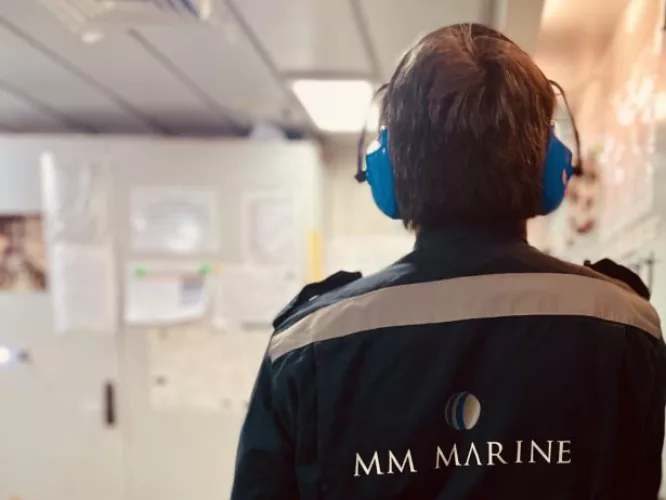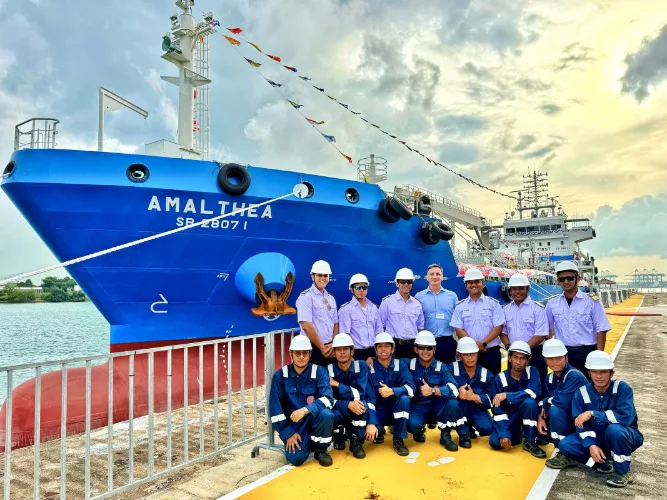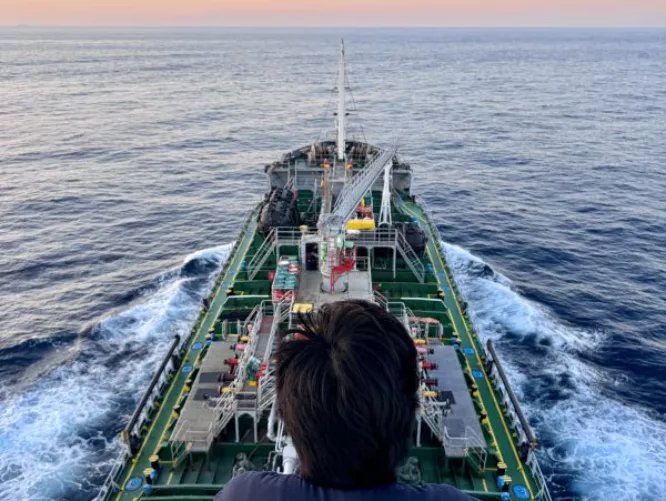Progress in 2024
Planet
Creating and maintaining an efficient energy system that sustains and protects our planet is one of the greatest challenges we face. Biodiversity loss and global environmental change, including climate change, are the defining issues of our time, with direct and profound impacts on societies and economies.
Our primary business focus is energy and we recognize the global challenge to ensure energy is delivered sustainably.

Energy mix
Over time, we’ve strategically diversified our portfolio through both organic growth and acquisitions, intentionally moving from a heavy reliance on oil to embracing lower carbon alternatives. Our business, once predominantly oil-based, has evolved and diversified significantly. We now emphasize gas and power trading, a shift clearly illustrated in the historical data figure on our traded volumes by product type. The ratio of oil to non-oil trades in our portfolio has declined significantly since our inception.
The diversification of our portfolio is part of our commitment to the energy transition. The transition towards more sustainable energy sources is crucial for the future of our energy infrastructure. We firmly believe in the ongoing importance of gas within this mix, given its role as a more environmentally friendly option compared to traditional high-carbon fuels and its reliability in supporting the integration of renewable energy sources.
Historical percentage of traded volumes by product type
Oil vs. non-oil ratio
CO2 intensity of commodities traded
We do not only manage the percentages of products in our trading portfolio, but also focus on the carbon footprint of these products. The figure presented below illustrates the carbon intensity of the energy commodities we trade, measured in grams of carbon dioxide equivalent (g CO2e) per megajoule (MJ) of energy. This evaluation covers our portfolio of traded energy products, which consist of oil, gas, power, and coal, as well as associated products like carbon certificates. Please note that our trading activities in metals are not included in this analysis. The metals business started growing in the second half of 2024, and we will be including its intensity in next year’s report. The trend depicted in the figure is downward, indicating a shift away from traditional fuels towards alternatives with lower carbon intensity. This includes an increased emphasis on trading in gas, power, carbon certificates and other clean energy products, aligning with our commitment to reducing carbon intensity in our energy portfolio.
While the trend of CO2 intensity is decreasing, the annual change in our trading CO2 intensity does not always show a consistent decrease, which is attributed to the natural fluctuation in trading behaviours in the evolving energy system across various markets in different years. Nevertheless, the change shows the enhanced carbon efficiency of our trading portfolio, aligning with our global commitment to achieving net zero emissions, while also ensuring global access to energy.
Beyond broadening our trading portfolio and transitioning towards more environmentally friendly energy sources, we remain committed to fostering the development of innovative low-carbon energy solutions. For examples of companies we have supported in this venture throughout 2024, please refer to our Partner Profiles.
Carbon management & carbon neutrality
As we progress towards our 2050 net-zero goal, we continue taking significant steps by decreasing emissions and channeling investments into the low-carbon sector and nature-based solutions. These efforts are crucial in aiding the global shift towards net zero, as well as advancing our company’s own net-zero trajectory. We are dedicated to investing in the energy transition and are proactively managing and reducing carbon emissions within our portfolio of investment companies. Our asset companies (in which we hold equity stakes) continue to work on reducing emissions where possible. This includes detecting and mitigating for leakages and implementing carbon capture technologies at some of the assets. Additionally, we have committed to offsetting all of our Scope 1 and 2 emissions for the year 2024.
2024 CO2 emissions
Over the years, we have been tracking and disclosing our greenhouse gas (GHG) emissions footprint, and making improvements in data collection and our approach. Last year, we digitized our reporting by partnering with Validere, a leading emissions management software provider, supported by a highly skilled team of GHG experts. Validere supports emission calculations, record-keeping, and updates to emission and conversion factors. This collaboration not only digitizes our reporting process, but also verifies our emissions calculations by recalculating all emissions for each asset. We continue to use Validere in 2024.
Our 2024 CO2 emissions across Scope 1, Scope 2 (Location-based) and Scope 3 (Categories 6, 8 and 9) for our in-scope assets:
* For one asset we have used the previous year’s values (Scope 1 – 100 Tonnes CO2e and Scope 2 – 157 Tonnes CO2e) due to a delay in receiving the data and no material increase in activity for the asset. These values are not considered materially different from last year.
✔ The marked figures were subject to limited assurance procedures by PricewaterhouseCoopers SA.
2024 CO2 emissions in scope 3 breakdown:
✔ The marked figures were subject to limited assurance procedures by PricewaterhouseCoopers SA.
Our emissions are calculated on an equity share basis. Asset emissions are calculated based on Mercuria’s percentage equity share of each asset and investment. Equity share gives a better reflection of our business model compared to the operational control basis as we are not primarily an operator of assets.
Commentary on changes: 2023 vs 2024
Yearly comparison of global GHG footprint on an equity basis in tonnes of CO2e:
Comparison of Scopes 1 and 2: 2023 vs. 2024
The figure above illustrates the changes of Scopes 1, 2 and 3 from 2023 to 2024. Scope 1 emissions decreased from 752,297* Tonnes CO2e in 2023 to 550,306** Tonnes CO2e in 2024 and Scope 2 emissions increased from 123,317 Tonnes CO2e to 134,768** Tonnes CO2e. The differences are attributed to operational changes in certain assets and changes in equity ownership.
* In 2023, venting from one of the assets was initially unaccounted for. As a result, the reported Scope 1 emissions for the year increased from 713,338 Tonnes CO2e to 752,297 Tonnes CO2e.
** In 2024, we identified additional Scope 1 and Scope 2 emission sources at one of our assets that had not been accounted for in the previous year. These newly identified sources are now included in our 2024 Scope 1 and Scope 2 emissions reporting amounting to 29,777 Tonnes CO2e and 17,781 Tonnes CO2e, respectively.
Comparison of Scope 3: 2023 vs. 2024
Scope 3 emissions increased from 3,298,421 Tonnes CO2e in 2023 to 3,661,032 Tonnes CO2e in 2024. As our business continues to grow, so does our movement of products through vessels and pipelines, and the business travel of our employees, which are a natural consequence of our growth into different products and regions.
Category 6: Upstream – Business travel
Scope 3 emissions related to business travel have increased from 6,775 Tonnes CO2e to 7,943 Tonnes CO2e from 2023 to 2024, respectively. This rise in emissions from our business flights is directly attributable to the expansion of our global operations, especially with our expanded metals business.
Category 8: Upstream – Leased assets
Our time chartering business remains the top contributor to our Scope 3 emissions, with a value of 1,721,889 Tonnes CO2e in 2023, increasing to 1,819,132 Tonnes CO2e in 2024. Other than the business growth, this increase is due to ongoing conflict leading to issues with availability of vessels and longer distances traveled by vessels. All these reasons lead to higher emissions.
In 2024, we continued tracking and benchmarking our vessels’ emissions through Maritech Services Limited’s platform, Sea. This is done via a direct line of communication with ship-owners, to obtain actual fuel consumption data, and emissions are calculated using ISO emission factors.
Category 9: Downstream – Transportation and distribution
Our emissions from pipeline transportation have increased from 632,499 Tonnes CO2e to 752,127 Tonnes CO2e from 2023 to 2024, respectively, and our voyage charter emissions increased from 937,259 to 1,081,830 Tonnes CO2e, respectively. These increases are a direct result of our growing business activities. In 2024, we refreshed our emissions methodology to more accurately track the laden leg of our voyages. We have not restated 2023 emissions.
Basis of reporting
The aim of this section is to outline and describe the methodology and scope that serve as the basis of preparation for the calculation and reporting of our Greenhouse Gas (GHG) footprint for the year 2024. The scope of the report includes Mercuria’s Trading business and Assets held at Mercuria Energy Group Ltd, as well as assets held at Mercuria Energy Group Holdings Ltd level.
Background
For several years, we have actively measured and reported our GHG footprint, consistently seeking enhancements in our process. We continue to improve data quality, processes around data collection and calculations when better data and approaches are available. In 2024, we continued our partnership with Validere, a third-party emissions management software provider, backed by a team of qualified experts. This collaboration started in 2023 and was aimed at digitizing and validating our emission calculations and streamlining our GHG reporting across multiple assets.
In addition to partnering with Validere, we also partnered with Maritech Services Limited by using their software – Sea. Sea offers a digitalized method for us to record, track and validate our voyage charter carbon emissions. This allowed us to enhance our underlying data collection methods and compare against IMO emissions reduction targets.
The following basis of preparation was employed for our GHG emissions calculations in 2024:
Guidance and Emission factors
We adhere to the GHG Protocol Corporate Accounting and Reporting Standard, as the guiding standard for our emissions. Given the diversity of our activities and investments, we have considered the principles from various guidance (e.g., IPIECA for oil and gas) for the respective activity. We continue to review and update our approach as new guidance becomes available.
Our approach, in order of priority, consists of the following steps:
- Reported Emissions: We report on emissions data reported in regulatory filings for our assets.
- Primary Data Collection: We collect primary data (e.g., actual consumption figures from invoices and management reports) to quantify emissions.
- Estimation with Derived Figures: When neither reported emissions nor primary data are available, we estimate emissions by applying derived figures to activity-based data.
Our emission factors are derived mainly from IPCC, ISO, DEFRA, EPA, and IMO. We update these factors annually to reflect the most recent publication versions and have also had them independently verified by Validere for accuracy and reliability.
Organizational footprint
We report our organizational footprint based on the GHG Protocol equity share approach. Asset emissions are calculated based on Mercuria’s percentage equity share of each asset. Equity share gives a better reflection of our business model compared to the operational control basis as we are not primarily an operator of assets.
The assets we own and operate cover a wide range of energy and energy-transition related assets. This includes terminals and warehousing for storage, bunkering vessels, renewable fuel refineries, gas and power assets, forestry and mining activities.
Scope of reporting
For the scope of this report, our focus is on assets and activities identified to have the largest impact in terms of emissions. This includes activities that involve combustion of fossil fuels and processes prone to atmospheric emissions through venting or similar processes. The largest sources of emissions include oil and gas production, biofuel refining, mining and transportation activities. Assets in the development stage, deemed to have a negligible GHG footprint, have been excluded from our analysis. We remain committed to periodically reevaluating their significance and will incorporate these assets into our reporting scope as they progress and develop further.
On an equity share basis, we have accounted for emissions from the chosen activities and investments in companies where our ownership exceeds 20%. The rationale for selecting this threshold is twofold: obtaining accurate data becomes considerably more difficult below this equity level and stakes smaller than this threshold contributes insignificantly to the overall emissions footprint.
These assets and investments include two bio-refining, two mining, six upstream oil and gas, one forestry, one warehouse, one alternative fuel, five terminals, a bunkering and freight businesses. The emissions also include Mercuria offices, data centres, transportation via ship or pipeline and business flights for Mercuria employees.
Scopes
The following is reported in the GHG protocol scopes:
Scope 1 – Direct emissions
- Mercuria assets, activities and companies we invest in: direct emissions from operational activities, which includes stationary and mobile combustion, flaring and venting and other related operational emissions.
- Direct emissions from shipping activities performed by vessels owned by Mercuria.
Scope 2 – Indirect energy imports
- Mercuria assets: purchased electricity, steam, heating and other energy imports.
- Mercuria offices and data centres: electricity and gas purchased.
Scope 3 – Selected categories
- Category 6: Upstream – Business travel
- Reported For Mercuria’s business flights.
- Category 8: Upstream – Leased assets
- Reported for Mercuria’s time chartering of vessels.
- Category 9: Downstream – Transportation and Distribution
- Reported for transportation of traded commodities via gas pipeline or marine vessel.
Further details on approach
-
- We adhere to the GHG Protocol Corporate Accounting and Reporting Standard
- The gases included in the calculations are those in the Kyoto basket of gases – the largest contributors are carbon dioxide and methane.
- Where possible, we have utilized supporting documents from the assets and companies we have invested in to determine emissions based on actual consumption data, or we have used GHG reports created for regulatory purposes. However, due to the widespread distribution of emission sources, challenges in data collection, or the limited scope of regulatory reports, we have occasionally resorted to estimating emissions using production or activity data. For these estimations, our centralized approach employs common emission factors and Global Warming Potentials (GWPs) as outlined in the IPCC’s Sixth Assessment Report.
- In addition to Scope 2 emissions from our assets and companies we have invested in, the scope includes emissions from our offices and data centres. In specific, we have included electricity and gas consumption from offices with a minimum of 15 employees.
- A fundamental part of our operations involves the trading of commodities among various parties, which necessitates the global transportation of physical goods across markets. This activity is directly related to Scope 3 emissions from categories 6 (Business Travel), 8 (Upstream Leased Assets), and 9 (Downstream Transportation and Distribution). Therefore, we have incorporated these Scope 3 emission categories into our emission reporting since they are most pertinent to our business model, ensuring a comprehensive assessment of our environmental impact.
-
- Category 6: Upstream – Business travel.
- We report on our business air travel emissions. Our travel agency stores details of all business flights. Our business travel emissions are then calculated directly from this data by a third-party, Atmosfair. Atmosfair is a third-party non-profit carbon footprinting & offsetting organization. They use our flight data to calculate our emissions using DEFRA emission factors.
- Category 8: Upstream – Leased assets.
- Our vessel chartering business is growing. We charter vessels on time charter, and consequently charter them to third parties for their own use. Emissions are calculated based on the total actual consumption of fuel across the period of the time charter during the year.
- Category 9: Downstream – Transportation and distribution.
- We have accounted for the primary sources of our downstream emissions, focusing on the maritime transport of commodities and the conveyance of gas through pipelines.
- Shipping emissions: The emissions include voyage charters for commodities transported using actual fuel consumption. This year we started using Sea, Maritech Services Limited’s platform for our shipping emissions. Sea contacts ship-owners directly to report actual fuel consumption, which Sea uses to calculate emissions using ISO emission factors. For some voyages where fuel data is not available, we have estimated emissions based on the distance and equivalent vessel type of other vessels reported on Sea.
- Pipeline: For gas transportation by pipeline, we estimate losses (from leakages or usage e.g., to power compressors by the pipeline operator) by applying IPCC emission factors based on the volumes transported during the year.
- In preparing this report, we have evaluated other Scope 3 emission categories. However, our distinct role in the value chain, primarily as an intermediary facilitating the exchange and temporary storage of a diverse array of commodities, sets us apart. Our unique position spanning various value chains across different industries without being a direct consumer or a major producer, has led us to exclude additional categories from our current reporting scope. We report only on Scope 3 categories where we have direct influence or meaningful control. The significant challenges in acquiring appropriate data also play a role in this decision. Emissions from production facilities we have equity in are already accounted for and included in our Scope 1 and Scope 2 calculations. We are committed to staying up-to-date with the evolving methodologies and guidance, aiming to refine our reporting practices in future periods.
- Category 6: Upstream – Business travel.
Independent practitioner's limited assurance report
Read the PwC limited assurance report on selected non-financial information published in this section of the Mercuria CSR website for 2024
Environmental releases
During the 2024 calendar year there was only one instance where our operations (inclusive of both Mercuria’s own entities and contract services working on our behalf) were deemed responsible for unauthorized releases into the environment which mandated involvement of authorities at a state, federal or national level.
None of the release events that occurred during 2024 resulted in any injuries or other hazardous situations such as fires or explosions. All mandated reclamation activities were conducted to the satisfaction of the overseeing authorities. Subsequent to any significant event a follow-up investigation is conducted to assess causal or contributing factors with the aim of identifying measures that might help guard against similar recurrence. As appropriate we also work to communicate across our various businesses any “lessons learned” as shared knowledge and seeking to ensure best practices are uniformly adopted.
In all cases where Mercuria or its contractors are involved in a situation where there is a release event and regardless of fault, as a standard practice the involved operations will take whatever appropriate actions are safely available to them to minimize and stop the source of the release, and to mitigate damage where possible. Our operations will then ensure that appropriate resources for spill clean-up are requested for any containment, recovery or remediation efforts that may be needed. Concurrently as appropriate, our operations will also seek to ensure that governing authorities have been properly notified in accordance with local legislative requirements.
As a result of some environmental related incidents within our businesses we paid a total of 88,600 USD as penalties in the 2024 calendar year. There is one additional instance of a safety related concern still outstanding with an agency where a cash security of 80,000 EUR was required, but which has not been included in the table below as the matter is still pending resolution.
* Exclusive of any spill events where another party had primary responsibility for the event or where notification was given to state federal or national authorities as a courtesy – but was not required.
These statistics are exclusive of any authorized / permitted discharges, events where authorities determined that Mercuria or its contractor were not the responsible party, or instances where notification to authorities may have been provided as a courtesy but was not mandated. Further, only penalties paid directly to governing authorities with oversight of health, safety or environmental issues are reported. Taxes or other regulatory fees that might also be paid to authorities are not included, nor are any other related expenses incurred for repairs or corrective work or amounts that might be paid to affected third parties or service providers in relation to an event.
Partnerships
HUB Ocean partnership

Mercuria and HUB Ocean have had an important strategic partnership since 2021.
HUB Ocean is based in Oslo, Norway and is a non-profit, technological foundation that is dedicated to unlocking and sharing ocean data. It is the first thematic Centre dedicated to the ocean.
HUB Ocean’s core product, the Ocean Data Platform (ODP), allows aggregation of unprecedented volumes of diverse ocean data sets. ODP itself is a global, open-source and integrated digital data ecosystem providing new and faster insight for the ocean we need and want.
This partnership brings many synergies by combining Mercuria’s expertise in the global maritime industry with HUB Ocean’s expertise as an international provider of market-leading ocean and maritime technological solutions. For example, experts from Hub Ocean and Mercuria participated together in the Summit of the Villars Institute, a Swiss foundation that aims to accelerate the transition to a Net Zero and Nature Positive economy through intergenerational collaboration and systems leadership.
In 2023, Minerva Bunkering sponsored Citizen Sea, a HUB Ocean app that seafarers and other users can use to upload photos of images of the ocean, along with geographic location data, and share it with researchers and scientists through the ODP. This provides access of real-time, remote data to researchers and scientists to map wildlife populations and identify migration patterns, as well as study the effects of marine waste on ecosystems. For NGOs, it can help them raise awareness about endangered marine wildlife and high-waste areas. Citizen Sea is already available on Apple Store and Google Play.
“We want to give them the ability to share their observations and help change the fate of the oceans. We know from our employees that there is a very strong wish to contribute to marine sustainability”
Victoria Attwood Scott / Head of Corporate Responsibility & Compliance, Mercuria
To change the fate of the ocean, we need to harness the power of Citizen Sea. Achieving ocean health is a massive collaborative effort that will require giving ocean citizens a greater say.
We continue to collaborate with HUB Ocean on newer versions of the Citizen Sea app and other exciting projects.
Read more about HUB Ocean in their Partner Profile.
Earth Innovation Institute partnership

Mercuria is proud to be partnering with The Earth Innovation Institute (EII). The EII helps states and provinces in tropical forest regions to shift to low-emission, nature-positive, socially-inclusive development.
EII adopts a comprehensive, long-term strategy to achieve this goal, focusing on the idea that increasing awareness across different sectors within states or provinces about the benefits of this shift can stimulate the necessary collective action and innovative public policies.
EII’s global team of 35 experts in rural development, carbon markets, geospatial analysis and public policy has helped fifteen states and provinces in Brazil, Colombia, Indonesia and Peru begin their transitions to climate- and nature-friendly development. EII was chosen as the lead partner by ten states and provinces in these countries who are members of the Governors’ Climate and Forests Task Force to support the participatory design of low-emission development plans and investment strategies.
EII, incorporated as a non-profit charity in California, is one of the co-authors of the regional, “jurisdictional” approach to low-emission development and is the leading organization globally supporting state-wide REDD+ programs to provide high-integrity verified forest carbon credits to the rapidly growing carbon market. Its analysis, publications and positions are frequently covered by major media outlets such as the Economist, Washington Post, Wall Street Journal and BBC.
In 2024, Mercuria’s funding continues to support the work of EII with multiple states in Brazil that helped define a legal framework for States to develop jurisdictional programs to stop deforestation. This included working with multiple law firms and academics to understand how States can access carbon finance for their actions to reduce deforestation. It also included capacity building for Amazon States to understand how to implement such programs.
Continue reading
← Governance in 2024
People in 2024 →
Reporting areas
Governance
Planet
People
Prosperity




